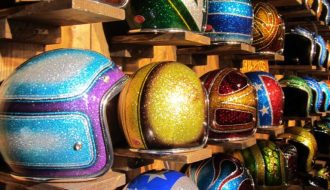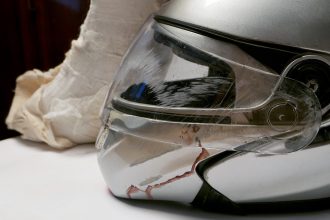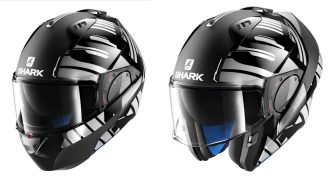Have you ever wondered what your motorcycle helmet is made of? What kinds of materials are protecting your head?
That’s exactly what got me thinking before I wrote this article. So I decided to put together a little guide and dug into the research.
Just in case you were thinking the same thing, read on and discover some amazing things.
What Are Motorcycle Helmets Made of?
Motorcycle helmets are constructed in 3 different layers. Each layer is designed to reduce the shock to the head in the event of crash. As there are differences between each layer, let’s look at each layer in more detail.
The Inner Comfort Lining

The comfy padding is the soft stuff that you feeling around your face when you have the helmet on.
It’s called the comfort liner. Its generally made from layers of soft foam rubber covered by a smooth fabric liner.
The main purpose of this section is to make the helmet feel comfortable around your head and at the same time apply a moderate amount of pressure to keep the helmet firm. So it won’t fly of in an accident.
The comfort liner can vary between manufactures. More expensive helmets have added moisture wicking materials in order to deal with the sweating part of wearing a helmet.
The Inner Crush Foam Lining
The inner foam lining is the bit you can’t see. It sits between the padding and the outer shell. You’ll find this is a thick layer of foam padding and it’s designed to crush on impact.
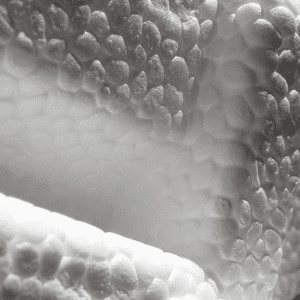
The reason that it crushes is to distribute the force of the impact through the shell so that it is absorbed by the foam. It is the foam that takes in all the punishment so the impact does not reach your head.
The foam itself is usually made from EPS (expanded polystyrene foam). The material is naturally stiff but lightweight, which makes it a perfect match for the job.
The price between a premium helmet and the cheap ones often starts here. Cheap helmets have a few layers of foam. Premium helmets come with more layers of foam that are strategically placed so that the rider has a better chance to escape head injuries.
If a helmet has DOT Certification, the foam and the padding can sometimes be pretty generic from helmet to helmet.
The Outer Shell
The Outer Shell is the part that takes the initial impact in a crash. It’s going to be the most important part in both a crash and in your wallet.
The difference in price between a standard helmet and and uber expensive one is based predominantly based on the construction of the shell.
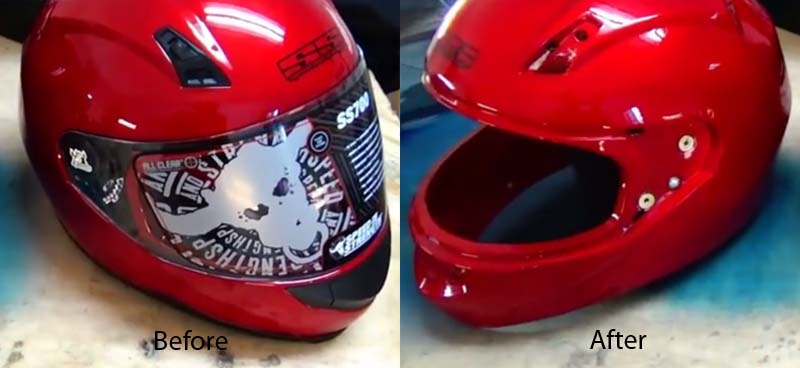
If you stripped all the parts of a helmet you would be left with the outer shell
This area basically spreads the impact from one point on the helmet to the rest of the shell with the aim of reducing its intensity during an accident.
If the impact was left in one area, it would have more impact on the head of the rider.
The other function of the shell is to deflect sharp objects that may come into contact with the helmet.
Helmets shell are made from many different composites, from Injection Molded Plastics to Kevlar.
Below is an overview of the various types of helmet shells.
The Different Types of Helmet Shells
The common materials used in the construction of the motorcycle helmets outer shell.
Thermoplastic Shells
This is the most common and is used for most regular helmets. Just like their name suggests, these types of helmets are made by heating a plastic material at high temperatures and injecting it into the molded shape.
Plastic helmets can easily shatter when dropped on the ground and that’s why these helmets use a lot of foam to protect the shell from breaking. They are generally designed this way, to crush on impact and expend the energy.
This explains why thermoplastic helmets are a bit larger and bulky.
Thermoplastic are a combination of several carbonate compounds. (EG: Polycarbonate) These molded helmets are not difficult to make and perhaps that’s why most come with a lower price tag.
They also don’t distribute the shock of an impact as well as other shell types. So manufactures tent to compensate for this by making them larger in size.
Fiberglass Shells
Most premium helmets are made from some kind of fiberglass as the outer shell. The making of a fiberglass shell is actually quite complicated. Not rocket science complex, but complex none the same.
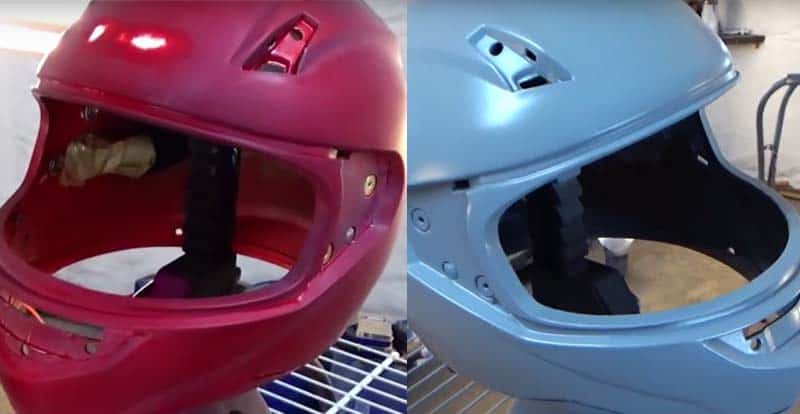
Motorcycle helmet outer shell
The process begins by putting fiber cloth into the mold and then injecting a resin. The mixture is then subjected to a high amount of heat so that the mold can result in a weave. In fact, the process is repeated many times.
Though helmets that are made from fiberglass are hard, they’re very brittle and hence can break into pieces when dropped accidentally. This attribute actually makes them safer than plastic helmets because they take all the impact and spare the head of the rider.
This is due to the fact that the energy of the impact is exhausted through the shell as it cracks to pieces.
Advanced Fiberglass Shells
The helmets in this category resemble the regular fiberglass shells. It’s only that the advanced fiberglass shell is constructed from several materials that include more flexible resins.
These helmets tend to have a thinner layer of foam due to the fact that the fiberglass is considered to be strong enough to withstand any force that might be experienced in an accident. This makes them lighter weight than regular helmets.
Carbon Fiber Shells
Carbon fiber is the planet’s new wonder material. It’s an incredibly strong material. In fact, it’s stronger than steel but a fraction of the weight.
This is the main reason it is used for almost all protective objects. First, it was spaceships and aircraft equipment and now, the automotive industry uses it from formula one racing cars, right through to popular super cars.
Carbon fiber helmets are no exception. The thin carbon-fiber strands are woven into a mat or piece of material that is molded into shape and then hardened by resin to make it a solid shape.
Kevlar Shells
Kevlar shells are the strongest helmets on the planet. We have all heard of bullet proof vests being made from Kevlar, so they must be strong.
These helmets are constructed just like fiberglass helmets except that they contain the Kevlar cloth. Kevlar fabric is chis-crossed over a helmet mold and set with resin.
Kevlar (made by DuPont) is a very reliable material due to its strength. However, helmets made from Kevlar are damn expensive because the materials are co costly.
How Helmets Prevent Injuries
The main purpose of putting on a helmet is to protect your brain during an accident. While most people think that the motorcycle helmet is worn to shield the skull.
That’s not true because skull injuries can heal fairly quickly.
On the other hand, riders that experience brain injury hardly live to tell the tale. Those that survive are not of good sound mind. The brain is therefore a crucial body organ that must be protected by all means possible.
When a crash involving a motorcycle happens, the head of the rider squeezes the inner foam liner. But due to its thickness, the inner foam liner crushes to absorb the impact.
It creates a barrier between the head of the rider and the outer shell.
Thick padding ensures that the head of the rider doesn’t exhaust the space between the shell and the inner liner.
What Are The Safest Helmets?
You can go for all the fancy helmet shells on the market, but that does not necessarily make them safe. For the average rider the exotic shell will really make little difference in an accident.
Read about the safest helmets in more detail here.
The best things to look for are;
- A helmet that Fits Perfectly with a secure chin strap
- Is a Full Faced Helmet Type
- Certification – either DOT, Snell or ECE
- Made from Good Materials (EG: composite fiberglass)
- Made by a good reputable Helmet Brand
The most important thing in determining the safest helmet is one the that is fitted correctly. Too loose or too tight is bad in an accident.
Conclusion
What do we do with this information?
The choice of a helmet is determined by how often you ride. Dot approved thermoplastic helmets are good enough for your every day casual riders that don’t travel for long distances. Since some can be heavy and big, this maybe a a disadvantage if you are a regular rider.
Fiberglass and advanced fiberglass are suitable for street racers and motocross enthusiasts. These helmets are lightweight and very durable due to their construction.
A helmet made from Carbon fiber and Kevlar is recommended for racing sports riders that travel at high speed. This is because they’re designed to withstand these extreme crash conditions.
We hope you find this information helpful. If you would like to support this site, you can by purchasing through recommended links on the page. Should you decide to purchase, we may earn a small percentage of the sale at no cost to you.
Thank you for your support.
Looking for a Replacement Helmet? Here’s a Recommendation
| Best Full-Face Motorcycle Helmet | Price | Rating |
|---|---|---|
| 5/5 rubber chickens | ||
| 4.8/5 rubber chickens | ||








